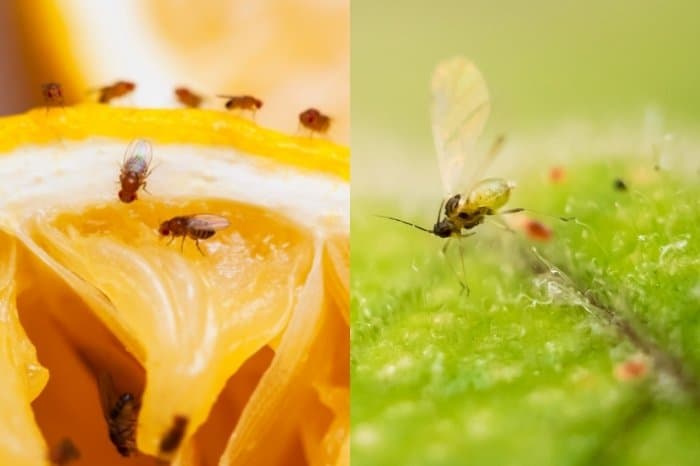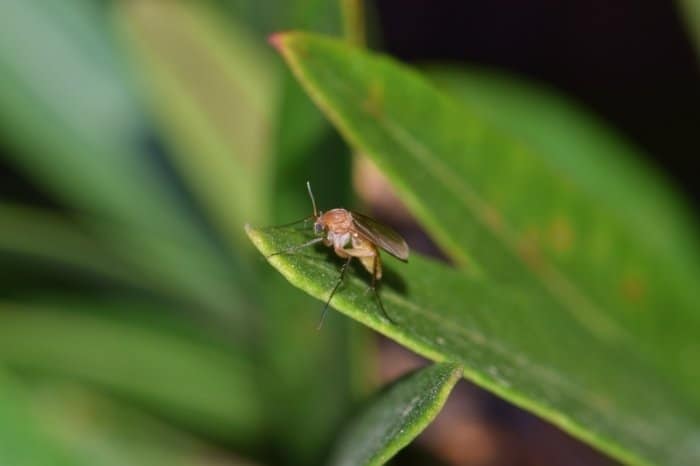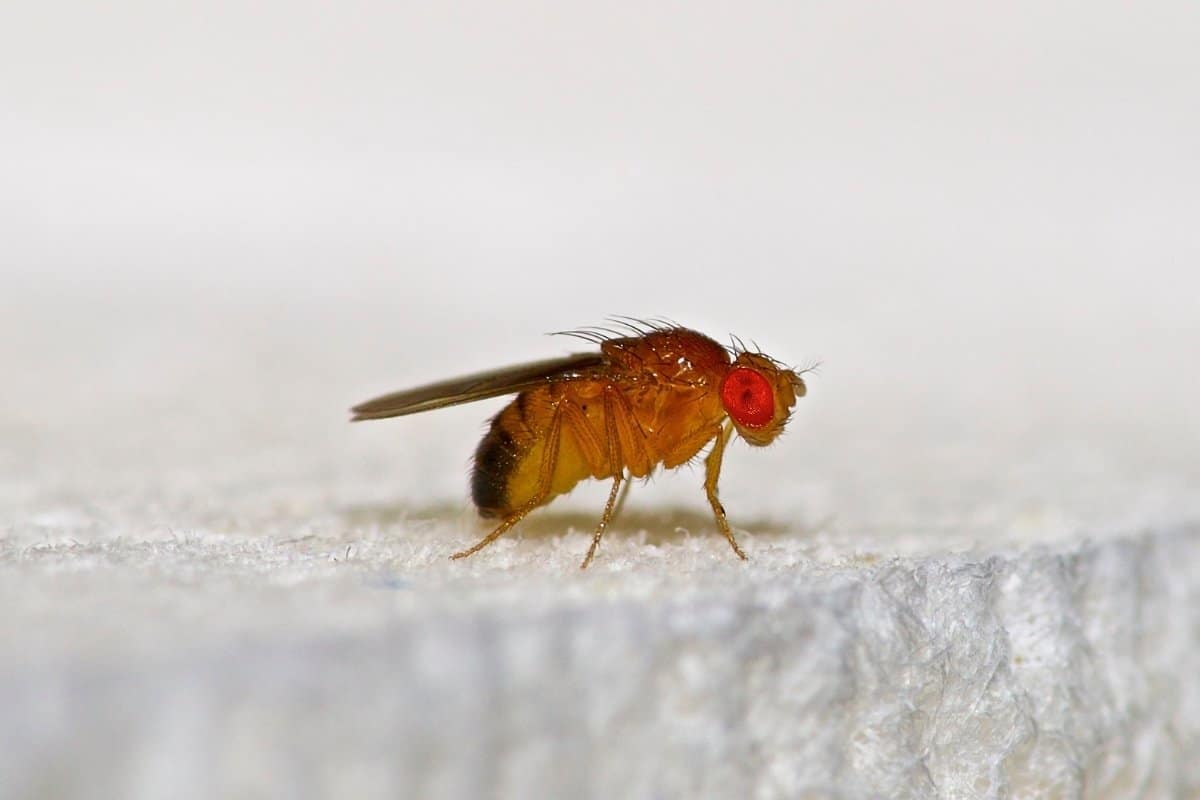Last Updated on January 8, 2023 by Urska
Do you know how to kill gnats in the soil or do they keep annoying you repeatedly and destroying your houseplants?
Fungus gnats or soil gnats are some of the most common and annoying indoor pests. These pests are attracted to high moisture and humidity.
You will start by noticing a harmless adult fly around your houseplants or gather around a closed window. They are non-biting but they become a flying nuisance.
At the larvae stage, they feed on your soil damaging the tender roots of your plants. The worst thing about fungus gnats is that they infest any indoor plant growing in soils. This means, if you have indoor plants, they will get into every one of them.
In this article, we will learn how to get rid of these annoying pests for good!
How To Identify And Kill Gnats In The Soil
The adult fungus gnats are delicate, grayish-black, mosquito-like flies that measure about 1/8 inch long. They have long legs and one pair of clear wings. They are not strong fliers and are noticeable around the potted plants, especially during watering.
Larvae or maggots have a shiny black head and an elongated whitish transparent body measuring about ¼ inch long.
Fungus gnats look the same as fruit flies, and most people seem to mistake these two.

However, they are not the same type of bug. Fruit flies are interested in the fruit smell that fills the house and do not destroy the plants.
The Fungus gnats love to lay their eggs in damp soils where the larvae hatch and feed on fungus, small roots, and other organic matter in the soil.
Here’s an easy way to tell the difference.
- Fungus gnats are tiny black bugs in the plant soil that fly around the plants.
- Fruit flies are insects that fly around a fruit or the garbage disposal in your kitchen.
Do Gnats Kill Plants And Soil?
No, fungus gnats do not kill your houseplants. These pests are a nuisance because they fly around the house but rarely destroy your plants. Sometimes, if the infestation is heavy, they may cause root damage but in most cases, fungus gnats will only eat rotting roots.
Even though they are not a major problem for your plants, they are likely to drive you crazy. Who wants all these flying insects all over their house?
Before we figure out how to eliminate them, it’s best to first understand where they come from in the first place. Then we can make sure they never come back.

Where Do Fungus Gnats Come From?
Fungus gnat infestation can come from anywhere. The most common way that these insects can get into your house is if they are in the soil of your newly purchased plant. Alternatively, they can also be in a bag of potting mix that you can bring indoors.
Fungus gnats can also be brought in with a plant that was outdoors during the summer. Worse still, they can fly in through the screen of an open door or window.
The Fungus Gnats Cycle
Fungus gnats adults have a lifecycle of about a week. They lay up to 300 eggs in rich, moist soils and within 4 to 6 days, tiny larvae emerge. They begin feeding on fungi, plant roots, or organic compost during their 2 week period.
Their pupae stage lasts 3 to 4 days before these young adults leave the soil and begin to fly around as adults.
The entire Fungus gnats life cycle from egg to adult may be completed in only 3 to 4 weeks depending on the indoor temperature. Because of their productivity and relatively short gestation, the potted plants can host them at each stage — egg, larvae, pupae, adult —all in multiple generations at once.
Due to this, fungus gnat treatment requires repeated applications until there are no remaining eggs.
Kensizer 20-Pack Yellow Sticky Gnat Traps Killer for Indoor/Outdoor
Severe Infestation Damage
As much as we have said these gnats do not cause any harm to the plant, but a severe infestation may cause some damage. The larvae are the most damaging to cuttings, seedlings, and young plants. Plant symptoms for heavy infestation include:
- Sudden wilting
- Yellowing
- Loss of vigor
- Poor growth
- Loss or death of the plant
Plants that are lost to injury include:
- African violets
- Carnations
- Geraniums
- Poinsettias
How To Get Rid Of Fungus Gnats In The Soil
It is critical to undertake fungus gnat control as a measure to keep your house free of these annoying insects.
Here are ways to control Fungus Gnats
Inspect your plants thoroughly before purchasing for any signs of insect pests. Carefully turn up soil near the base of the plant looking for the glossy, clear larvae. Do not buy any plant that has any signs of these gnats.
Fungus gnats thrive in damp soils; therefore, do not overwater your indoor plants, especially during cold months when plants use less water. When potting, avoid using water-holding containers, and organic material like peat moss that may encourage egg-laying.
If you notice these pests are already present, leave your soil to dry to a depth of 1 to 2 inches between watering. This will kill the larvae and inhibit the development of eggs. The dry soil also makes it less attractive to egg-laying females.
Use yellow sticky traps placed horizontally on the soil surface to capture large numbers of egg-laying adults. The gnats are attracted to colorful sticky traps so use yellow or pink ones. Once stuck to the trap, you can easily remove them from the trap before they lay more eggs.
Use hydrogen peroxide as a soil drench by mixing 1 part peroxide with 4 parts water. Pour it through the soil at the root zone until it comes out of the base of the pot. The peroxide kills these fungus gnat larvae on contact.
Use neem oil as an effective soil drench to combat fungus gnat larvae. Dilute the oil with water according to the manufacturer’s directions and drench the soil directly at the roots of the plant. You may also spray the upper part of the plant to keep adult gnats at bay.
What Potting Soil Doesn’t Have Gnats?
It is essential to know what potting soil doesn’t have gnats if you aim to maintain a healthy garden. Gnats that go unnoticed or untreated can have detrimental results on your garden plants, making all your efforts go to waste. Soil with exceptional drainage properties usually doesn’t accommodate these little critters as gnats thrive in moisture-rich dirt.
Adding vermiculite or perlite to your usual potting soil will enhance its drainage properties, leaving no room for fungus gnats to thrive. Also, an addition of sand on top of your potting mix will aid in keeping the growing medium dry. This will steer gnats away as they don’t like laying eggs in dry environments. If you want to get a ready-made mix that is non-bark or compost and has excellent drainage capabilities, then Miracle-Gro Indoor Potting Mix is recommended to keep gnats away.
How Long Can Fungus Gnats Live Without Soil?
If you want to know how long can fungus gnats live without soil, then take heed of the following information. You would be glad to know that both adult gnats and their larvae have very short lifespans without moisture-rich soil. They usually last a day or two before they move on or expire. To get rid of them and avoid any unwanted infestations, you should leave the soil to completely dry out if they have started to invade it. This will steer them away quite quickly, without the chance to continue infesting your plants.
How Long Can Fungus Gnats Live in Bagged Soil?
Have you ever wondered how long can fungus gnats live in bagged soil? If that is the case then read the following information. Fungus gnats can live in bagged soil for about a week after they have laid their eggs. Thereafter, these eggs hatch and form larvae which thrive on decayed plant materials and fungus that air in the bagged soil.
They take about two weeks to mature into full-grown adults and continue the cycle once again. This is why untreated soil sees an increase in these critters as they continue to grow their population in the soil if left alone. To rid them of bagged soil, empty the dirt into a large bowl and soak it thoroughly with boiling water. This process will kill both the adult fungus gnats and the eggs they have laid. However, if the infestation has continued for an extended time and you fear that your bagged soil has been flawed, discarding it would be best in this case.
How Deep in The Soil Do Fungus Gnats Live?
If you’re thinking about how deep in the soil fungus gnats live, then hear me out. These unwelcomed creatures actually occupy the top two or three inches of dirt. However, this will also depend on the growing mediums’ moisture levels as fungus gnats thrive in moisture-rich soil. Primarily, gnats thrive on decaying plant matter in the soil, the roots of plants, and fungi that exist in the soil.
However, seeing that they generally invade the top few inches of the soil, when disturbed, you will see them emerge although they are not very stealthy flyers. They also commonly lay in rows close to the plant’s stems and hatch every four days. If the weather is warm and the food and moisture supply is plenty, fungus gnat infestations may last much longer than you’d like.
How Do You Check For Gnats in Soil?
Knowing how do you check for gnats in the soil can be advantageous to stop their advancement before the infestation increases. To check for gnats in the growing medium, several home remedies can be used. You can place traps that include raw potatoes cut up as gnat larvae are drawn to them.
This process is also great to steer these little critters away from your plant’s roots. Additionally, you may also spot tiny off-white colored eggs on the surface of the soil. These are usually laid on the surface by female fungus gnats. Hatched larvae have transparent bodies and shiny heads which are easy to spot in the soil.
Conclusion
It is easy to kill gnats in the soil using organic solutions that will not harm your plants or pets and is not toxic to your house environment. Go ahead, choose your favorite solutions, and eliminate these fungus gnats for good!
FAQs
FAQs
What home remedy kills gnats in soil?
I have been battling with gnats for the past week. I had a problem when I was growing tomatoes and peppers last year, but it is not happening this year.
I have tried using some of the chemicals recommended on-line and it seems to have little effect. I have been using insecticidal soap and it seems to be working, but only temporarily.
If you're talking about the gnats that come out of your plants, I'd try something like: Drain water from plant pots. Add a little dish soap to the water (about 1/2 teaspoon). Fill pot back up with fresh water and let sit overnight. Empty the next morning. I've used this trick successfully on my indoor plants before.
What kills gnats instantly?
I know I have heard that insecticide (which I assume is a broad term) can be used to kill them. I have read about it on the internet and also read that they can get on you or your pets. You might try an aerosol insecticide. I've seen some on the market labeled for this purpose, and they work very well.
I have tried using a spray with some sort of insecticide and it does work, but it's messy. The insecticide gets on your skin and clothes, and on the furniture. I like to use something that is not dangerous for pets and children. There are several ways to kill gnats. The first is to pour boiling water on them, but this won't work for all species.
Does vinegar get rid of gnats in houseplants?
Yes, I have used vinegar for this purpose. I have found that the best way to apply is to pour a small amount into a shallow pan or bowl and use a spray bottle to mist the plants.
How does vinegar and baking soda get rid of gnats?
Baking soda is an alkaline, which neutralizes the acid in vinegar. The two are combined in a spray bottle to form a solution that will kill gnats. The reason it works is because baking soda is an alkali, which is basically any chemical that is heavier than water.
I use 1/2 cup vinegar and 2 cups baking soda in a spray bottle. It works well for me.
Baking soda is a very good attractant for flies. It attracts them to its own smell, which they find irresistible, and it also kills them. They are attracted by the vinegar smell, and then get drowned in it.
Are gnats attracted to apple cider vinegar?
The answer is yes, but you don't need to pour it into your sink or anything like that. They will get the scent of the ACV from the air. As you can see in this video, the gnats come to the cider vinegar and then they start flying up, and as soon as they're up there, they start drinking the vinegar.
So you can use it to make your own gnat traps.
How do you keep gnats out of plants?
You may be able to get away with using an insecticide that is "fungal" in nature. I don't know if there is one specific insecticide for this purpose, but you could try mixing something like Dipel with a product called "Serenade".
Caroline is a gardener who loves to get down to the nitty–gritty of gardening. She proudly proclaims herself as a ‘dirt worshipper‘ and can often be found deep in the garden, covered in soil and singing to her plants. As a self–proclaimed ‘plant whisperer‘, Caroline believes that plants need love and attention just like any other living thing, and she loves to give them both. When she‘s not tending to her garden, you can often find her researching the latest gardening trends, or teaching others how to make their gardens thrive



